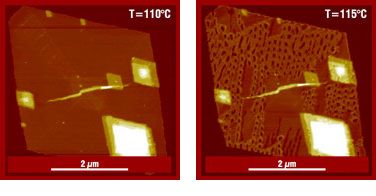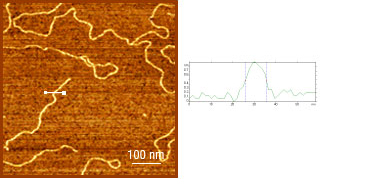The resolution in AFM depends on the shape of surface features, the mechanical properties of the sample, and its interaction with the AFM tip. There are many of AFM applications where the size of the surface features to resolve is in the 10-150nm range, thus not requiring AFM tips with a radius smaller than 10nm. Fig. 1 demonstrates clear resolution of large macromolecules along with submolecular features such as branches.
| Fig. 1. Height images of dry single crystals of polyethylene measured at 110°C temperature and after 1.5hr annealing at 115°C. Height histograms corresponding to AFM show the evolution of lamellar thickness after annealing at different temperatures. (*D.A. Ivanov, et al., Macromolecules, 35, 9813- 9818 (2002)). |
 |
High resolution may not be attainable when imaging real-time processes such as molecular diffusion, crystallization, and wetting. This depends on the characteristic process rates in relation to the scanning rate and the distance between the scan sampling points. Moreover, sharp AFM probes needed for high resolution imaging require special care in use, which leads to further reduction of the scanning speed. The 5nm resolution offered by standard tapping and contact mode AFM tips may be a compromise in this case.
Standard AFM probes are uncoated silicon AFM tips that can be usually used in contact, non-contact or tapping mode for imaging topography and mapping mechanical properties without significant limitations. Imaging of DNA is one of the examples of such applications (see Fig. 2).
| Fig. 2. Tapping mode topography image of DNA (Agilent 5500 AFM, former diamond SCD probe). Scan size 750nm. Scan height 1nm. Image courtesy of S. Magonov, Agilent Technologies. |
 |
Standard AFM probes having AFM tips with a radius below 10nm provide good-quality images for a broad variety of samples. The best resolution is achieved when scanning spherical particles that are hard and exhibit weak attraction to the tip. Note that the resolution of AFM images larger than 1×1µm may be more determined by the density of sampling points ratio than the AFM tip radius.
General recommendations apply to the AFM cantilever choice. Contact mode needs AFM probes with small spring constant below 1N/m, non-contact mode requires high-frequency AFM probes, while AFM cantilevers with intermediate spring constant and resonance frequency are optimal for most samples in tapping mode.

